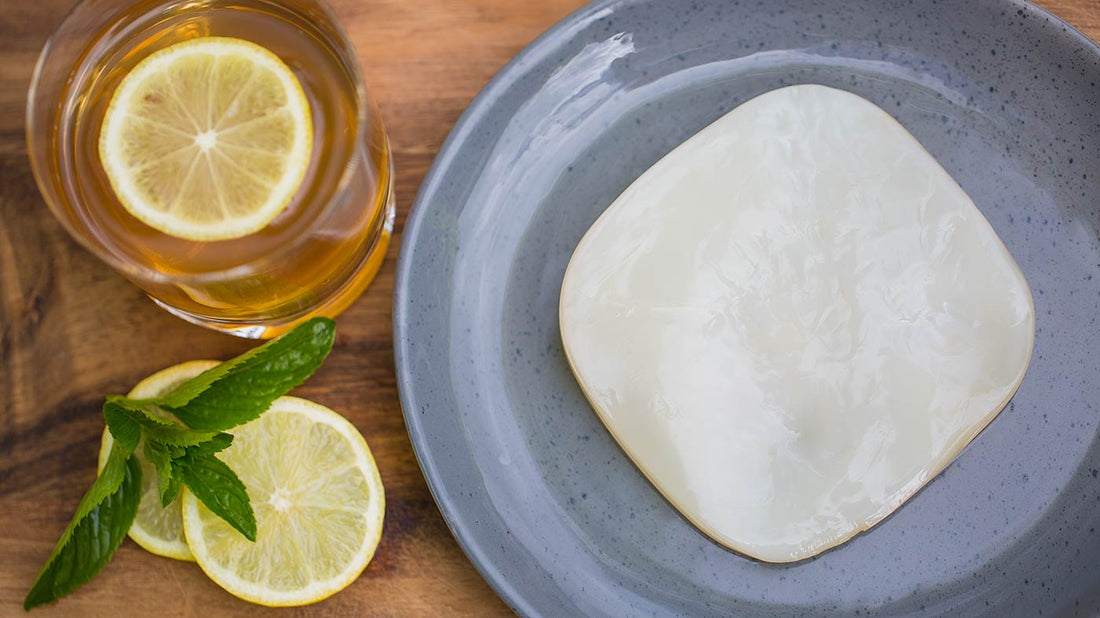Kombucha is an ancient, probiotic beverage that has been enjoyed for generations. Over the last few years, kombucha has made a comeback for those seeking a tasty, low sugar probiotic drink.
Whilst delicious, regularly buying premade kombucha can be an expensive exercise which is leading more and more people to start brewing kombucha at home themselves.
Before starting your own homemade kombucha brew – make sure you know these things:
The Quality Of The Kombucha Depends On The Quality Of Your Ingredients
The SCOBY required to brew your homemade kombucha is a living community of many organisms that need the right balance of nutrients to thrive. A happy, healthy SCOBY can deliver you with great tasting kombucha for a very long time so it is important to look after it with quality food.
Essentials:
- Filtered water – free of chlorine and fluoride, these chemicals will kill off the healthy probiotics found in the kombucha brew.
- Organic Tea – pure tea leaves from the Camellia sinensis plant. Teas with added oil and herbal teas must be avoided as they will go rancid and not feed the SCOBY sufficient nutrients. Stick to black tea when you are first starting for the best results.
- Sugar – standard white sugar is the easiest for a beginner kombucha brewer, however many will prefer organic evaporated cane sugar for the best balance of relatively unprocessed sugar and a healthy SCOBY.
- Starter Tea – when you buy a SCOBY from the Homemade Kombucha Co. it comes pre-packaged with the starter tea for a 2L batch. If you don’t have enough starter tea to maintain the right acidity level – use distilled white vinegar.
Avoid:
- Teas with oils added such as Earl Gray, Chai and flavoured teas.
- Non-organic tea – these often have high pesticide contents which will be passed into the kombucha brew.
- Sugars with molasses content like brown sugar, rapadura sugar etc.
- Tap water – in Australia tap water normally contains chlorine and fluoride which will harm the probiotic culture.
- Vinegars like raw apple cider vinegar and wine vinegars have their own bacterial content which will compete with the SCOBY.
Your Brewing Process Will Make Or Break Your Kombucha Brew
When done correctly, brewing homemade kombucha is a straightforward process. However there are many subtleties that a beginner brewer may miss that can have a big impact on the results.
What To Do:
- Follow strict hygiene – avoid introducing competing (and possibly harmful) bacteria. Wash your hands, sterilise all utensils and brewing containers. Do not use bleach or strong anti-bacterial disinfectants as any residue may kill your SCOBY. Make sure everything is cool before coming in contact with the starter tea culture or the SCOBY.
- Find a good spot for your brew – clean out the spot from any dust etc beforehand. It must be dark, clean, where it will not be disturbed and have sufficient oxygen. A medium sized empty cupboard is ideal.
- Read through our instructions page here and follow each step carefully. We highly recommend reading through the notes section as well.
What To Avoid:
- Harsh cleaning chemicals – any residue from bleaches, detergents and anti-bacterial soaps can harm the probiotic culture.
- Strong heat – if sterilising using boiling water or heat, keep in mind this will harm the culture if things haven’t cooled down first.
- Metals – the ionic charges from metal can inhibit good bacteria growth, and make it easier for dangerous bacteria to grow.
- Plastic brewing containers – plastic chemicals like phthalates and BPA can leach into the kombucha from the high acidity level.
- Sunlight – direct sunlight and heat will interfere with the fermentation process, either leading to batch failure or a strong, vinegar tasting kombucha.
A Few Key Points For SCOBY Care
For most of its life the SCOBY will be in the brewing container enjoying the quality tea and sugar you have fed it with. It will only need to be handled briefly when starting the homemade kombucha brew or when separating the ‘mother’ and ‘baby’ SCOBY when harvesting the kombucha for drinking.
Avoid touching the SCOBY to prevent cross contamination.
Human skin is covered with thousands of microbes, some of which can be very harmful like Staphylococcus aureus. If you have used a strong chemical disinfectant before touching the SCOBY, any residue may also be harmful.
The best way to avoid contaminating the SCOBY or harming it with chemical residue is simply to avoid touching it.
Avoid metal contact with the SCOBY
Metal brewing containers are best avoided for kombucha, and so are any metal utensils like tongs, spoons and strainers. This is because of the ionic charges that metals can create, these charges can have an antibacterial effect for good bacteria – encouraging the growth of bad bacteria.
When you are transferring the SCOBY it is quite easy for it to come in contact with metals in jewellery, or for it to fall into a metal sink if you are not careful. None of these are good for the SCOBY and may encourage contamination of the culture with pathogens.
Plan ahead and be cautious to avoid this happening – remove jewellery and use a glass dish to transfer the SCOBY. To strain yeast and immature SCOBYs from the final kombucha brew – use a fine mesh metal free strainer like this.
Avoid strong heat and keep temperatures stable
The SCOBY will perform best at about 20-25°C – colder temperatures than this can make the culture go dormant, which will stop the fermentation process.
If things get too warm, it will accelerate the fermentation process meaning that you will have a quicker kombucha brew but it will probably taste more like vinegar. Quick kombucha is usually not the best.
Very hot temperatures can ‘cook’ the culture, killing off the good bacteria. Keep this in mind when using containers or utensils that have been sterilised with boiling water or are fresh out of the dishwasher. Let things cool to room temperature to be safe.
How To Tell If It Has Gone Right Or Wrong
For the first time brewer you may be bit nervous about how things have gone (see here for healthy SCOBYs).
Gone Right: Homemade Kombucha Success
- Baby SCOBY formed – a layer of clear/off-white film appears on the surface which gradually thickens into a new SCOBY.
- Acidic, vinegar-like smell and taste – as the brew ferments the sugar will be broken down and turned into acidic compounds, creating a tangy, vinegar-like taste.
- Low pH – 2.5 – 4.0 – a lower pH is the sign that the acidity has increased and that everything has gone well. Monitor the brew with pH strips.
Gone Wrong: Start Again
If there are any of these signs your batch has been contaminated and should be thrown out. Do not try to salvage a bad batch of kombucha or a SCOBY that has been exposed to contaminants.
- Smells bad, rancid or cheesy – a sign of contamination.
- Mould – white, black, green, any fuzzy growths on the SCOBY or liquid surface.
- Cross contamination of bacteria or yeasts – obvious changes in appearance and smell.
- Pests – flies, ants or maggots.
- Black SCOBY – the culture has died.
- Taste and smell hasn’t changed – temperature is probably too cold and the culture is dormant, move to warmer area to start fermentation.

